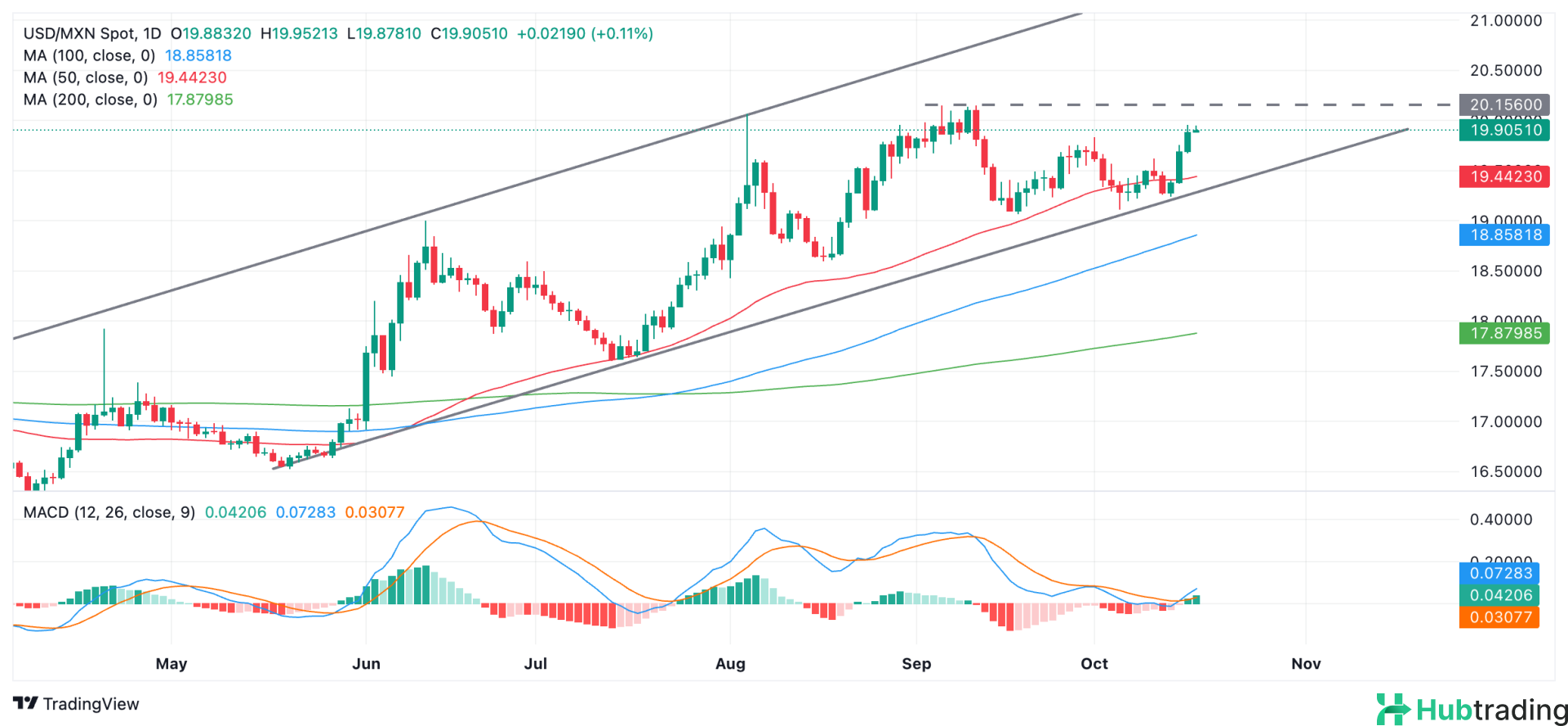- The Mexican Peso continues its decline for a fourth consecutive day, with multiple risks prompting traders to sell.
- Threats of tariffs from Trump, an important IMF report, political uncertainties, and disappointing economic data are all contributing to the Peso's struggles.
- USD/MXN extends its rally from the base of a significant rising channel, with technical indicators showing bullish momentum.
The Mexican Peso (MXN) appears to be repeating its recent depreciation trend on Thursday, as market bears gain confidence in the ongoing downtrend, pushing the Peso lower across all major pairs.
Several factors are contributing to the Peso's decline, including former President Donald Trump's threat to impose tariffs of up to 300% on Mexican auto imports, an International Monetary Fund (IMF) report highlighting a slowdown in economic activity, political risks, and a drop in Consumer Confidence data for September.
Mexican Peso Weakens Amid Trump’s Tariff Threats
The Peso fell an average of 1.5% on Tuesday after Trump stated in an interview with Bloomberg News that “Mexico is a tremendous challenge for us.” He pointed to China's establishment of large car-manufacturing plants along the US-Mexico border, which he claimed are flooding the US market and undermining American competitors.
Trump promised to combat this by reinstating high tariffs, aiming to revitalize the US auto industry. Given the importance of the automotive sector to the Mexican economy and the Peso's reliance on exports to the US, his comments have negatively impacted the MXN.
Peso Under Pressure from IMF Report
The Peso faced additional weakness following an IMF report that projected GDP growth to slow to 1.5% by the end of 2024. This forecast follows a recent GDP growth rate of 2.1% for Q2 and is below the Bank of Mexico's own 2.1% estimate for 2024. While slightly higher than the average of private-sector forecasts in Banxico's September survey (1.45%), it reflects concerns over “binding capacity constraints, tight monetary policy, weaker-than-expected US growth, and the unforeseen effects of recent institutional reforms,” which have unsettled markets.
The main reasons for the slowdown were given as “binding capacity constraints and a tight monetary policy stance” as well as weaker-than-expected growth in the US and the “unforeseen effects from recent institutional reforms”, according to the report. The latter refers to the controversial judicial reform, which has spooked markets.
In regards to headline inflation, the IMF saw this falling to the Bank of Mexico’s (Banxico) 3.0% target in 2025, in line with the central bank’s own forecasts but below the Banxico survey average forecast of 3.86% (3.80% median).
Banxico Expected to Cut Rates
Further downward pressure on the Peso is expected from anticipated interest rate cuts, which could deter foreign capital inflows. The central bank is projected to reduce the prime interest rate by 50 basis points (0.50%) before the end of 2024, bringing it down from 10.50% to 10.00%.
This is reflected in Banxico’s survey mean forecasts, with respondents predicting an average bank rate of 10.04% by the end of 2024 (median 10.00%) and 8.09% by the end of 2025 (median 8.00%).
Technical Analysis: USD/MXN Continues Recovery
USD/MXN is extending its recovery from the support provided by the base of a rising channel and the nearby (red) 50-day Simple Moving Average (SMA).
USD/MXN Daily Chart

The daily chart shows that USD/MXN is likely in a short-term uptrend, aligning with the technical analysis principle that “the trend is your friend.”
A break above the October 1 high of 19.83 could lead to a move towards the 20.10-20.15 range, approaching the September 10 high of 20.13.
The Moving Average Convergence Divergence (MACD) (blue line) is rising sharply and has crossed above its (red) signal line, further indicating a bullish outlook.





